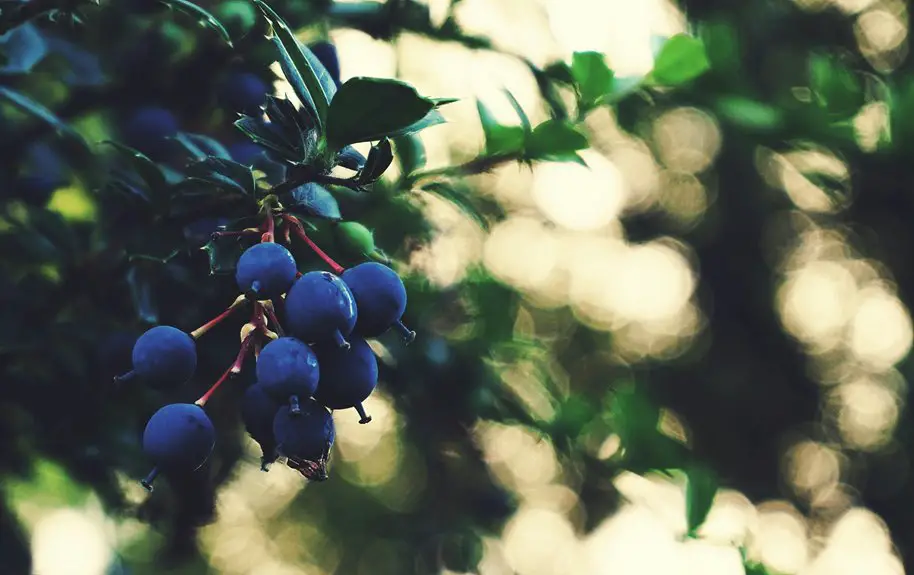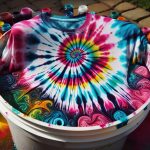To successfully remove mulberry stains, act quickly by blotting with cold water—never hot—to avoid setting the deep purple pigment. Apply liquid dish soap or a diluted white vinegar solution to break down the stain, gently rubbing before rinsing. Use an enzyme-based detergent for washing, avoiding bleach on colors. Test lemon juice carefully for tough stains. Taking these steps will boost your stain-fighting success, and exploring more tips can help you handle even the toughest fabric challenges.
Table of Contents
Key Takeaways
- Blot mulberry stains gently with cold water immediately to avoid spreading and prevent setting into the fabric.
- Apply liquid dish soap directly to the stain, gently rub, let sit 5–10 minutes, then rinse with cold water.
- Use a diluted white vinegar solution to blot the stain, let sit 10 minutes, then rinse with cold water.
- Treat stains with fresh lemon juice, expose to sunlight for 5–10 minutes, then rinse and wash as usual.
- Always test treatments on a hidden fabric area and avoid heat until the stain is fully removed to prevent setting.
Understanding Mulberry Fruit Stains
Mulberry fruit stains are notoriously stubborn because their deep purple pigments, called anthocyanins, bind tightly to fabrics and surfaces.
Mulberry stains cling tightly due to anthocyanins, making them exceptionally difficult to remove from fabrics.
When you deal with a mulberry stain, you’re facing a natural dye that penetrates fibers quickly, making it tough to lift. These pigments react with moisture and heat, which can set the stain permanently if you’re not careful.
You’ll notice that the stain’s intensity depends on how fresh it’s and the fabric type. Natural fibers like cotton absorb the pigment more readily, while synthetic ones might resist it slightly.
Understanding this helps you choose the right approach. You’ll want to tackle the stain with methods designed to break down these strong pigments without damaging your fabric’s integrity.
Immediate Actions to Take After Staining
When you notice a mulberry stain, gently blot the area instead of rubbing to avoid spreading it.
Always use cold water, as warm water can set the stain deeper into the fabric.
Taking these quick steps can make the stain much easier to remove later.
Blot, Don’t Rub
Although it might be tempting to rub the stain immediately, you should always blot the affected area instead. Rubbing can spread the mulberry juice, pushing it deeper into the fabric fibers and making the stain harder to remove.
To effectively blot the stain, follow these steps:
- Use a clean, white cloth or paper towel to gently press on the stain, absorbing as much liquid as possible without spreading it.
- Replace the cloth frequently to avoid transferring the stain back onto the fabric.
- Work from the outside edges toward the center to prevent the stain from expanding.
Use Cold Water
A small amount of cold water can make a big difference in preventing mulberry stains from setting. As soon as you notice the stain, gently pour or dab cold water onto the affected area. This helps dilute the pigment and prevents it from bonding deeply with the fabric fibers.
Avoid using hot water since it can cause the stain to set permanently. After applying cold water, continue to blot the stain gently with a clean cloth or paper towel to lift as much color as possible.
Keep repeating this process until no more color transfers. Acting quickly with cold water buys you time and increases your chances of complete stain removal later on during the washing process.
Pre-Treating the Stain With Cold Water
Before applying any stain removers, you should rinse the mulberry stain with cold water to prevent it from setting. This initial step is essential because warm or hot water can cause the pigment to bind more firmly to the fabric fibers.
Here’s how to pre-treat effectively:
- Hold the stained fabric under a cold running tap, allowing the water to flow through the back of the stain.
- Gently rub the fabric together to help loosen the stain without spreading it further.
- Continue rinsing for several minutes until the water runs clearer, indicating that some pigment has been washed out.
Using Dish Soap for Effective Stain Removal
Anyone dealing with mulberry stains can turn to dish soap as a powerful cleaning agent. Start by applying a small amount of liquid dish soap directly to the stain. Gently rub the fabric together or use a soft brush to work the soap into the fibers. Let it sit for 5–10 minutes to break down the fruit’s pigments. Rinse with cold water and repeat if necessary. Dish soap’s grease-cutting formula helps lift the stain effectively.
| Step | Action | Tip |
|---|---|---|
| Apply soap | Use liquid dish soap directly | Avoid bar soap for better penetration |
| Rub gently | Work into fabric fibers | Use soft brush for stubborn stains |
| Wait | Let sit 5–10 minutes | Don’t let it dry completely |
| Rinse | Rinse with cold water | Repeat if stain persists |
Applying White Vinegar to Break Down Pigments
Three simple steps can help you apply white vinegar to effectively break down mulberry fruit pigments.
First, dilute white vinegar with an equal amount of cold water to prevent fabric damage.
Second, soak a clean cloth in the solution and gently blot the stained area—avoid rubbing, as this can spread the pigment.
Third, let the vinegar sit on the stain for about 10 minutes to break down the pigment molecules.
Afterward, rinse the fabric with cold water to remove vinegar and loosened pigment.
Repeat these steps if necessary before laundering as usual.
The Role of Baking Soda in Stain Lifting
You’ll find baking soda is a powerful natural cleaner thanks to its mild abrasiveness and alkaline nature.
When you apply a paste of baking soda and water to mulberry stains, it helps lift the pigment without damaging fabric. Letting it sit for a few minutes before rinsing boosts its effectiveness on stubborn marks.
Baking Soda Properties
Baking soda works wonders when it comes to lifting mulberry fruit stains because of its mild abrasive and alkaline properties.
These qualities make it effective at breaking down and neutralizing the pigments in the stain without damaging the fabric.
Here’s how baking soda helps:
- Mild Abrasive Action: It gently scrubs the stained fibers, loosening the pigment particles without harming the material.
- Alkalinity: Its slightly basic nature neutralizes the acidic components of mulberry juice, preventing the stain from setting deeper.
- Odor Absorption: Baking soda also absorbs any lingering fruity odors, leaving your fabric fresh.
Application Techniques
Although mulberry stains can be stubborn, applying baking soda correctly can make removal much easier. You want to create a paste by mixing baking soda with water, then gently apply it to the stain. Let it sit for 15-20 minutes to lift the pigment before rinsing. Avoid scrubbing harshly, as it might damage the fabric.
Here’s a quick guide to application techniques:
| Step | Action | Tip |
|---|---|---|
| 1 | Mix baking soda and water | Use equal parts |
| 2 | Apply paste on stain | Cover fully |
| 3 | Let sit for 15-20 minutes | Don’t exceed 30 minutes |
| 4 | Rinse with cold water | Avoid hot water to prevent setting |
Follow these steps to maximize stain lifting power.
Effectiveness on Mulberry Stains
One key reason baking soda works well on mulberry stains is its gentle abrasive nature combined with its alkaline properties. This combination helps break down the pigments and lift them from fabric fibers without causing damage.
When you use baking soda, you’ll notice how it neutralizes the acidic components of mulberry juice, making the stain easier to remove.
Here’s why baking soda is effective on mulberry stains:
- It loosens pigment molecules by raising the pH level, reducing stain intensity.
- Its fine texture gently scrubs the fabric, aiding physical removal of stain particles.
- It absorbs moisture, preventing the stain from setting deeper into fibers.
Using baking soda gives you a safe, powerful way to tackle mulberry stains efficiently.
Utilizing Hydrogen Peroxide Safely on Fabrics
When you use hydrogen peroxide to tackle mulberry stains, you need to handle it carefully to protect your fabric.
Start by testing a small, hidden area to check for any discoloration or damage. Hydrogen peroxide is a mild bleach, so it can lighten some materials.
Apply a small amount directly to the stain and let it sit for a few minutes. Avoid soaking the fabric, as overuse might weaken fibers.
After treatment, rinse thoroughly with cold water to remove all residue. If the stain persists, repeat the process but don’t exceed two applications in one session to prevent damage.
Always work in a well-ventilated area and wear gloves to protect your skin from irritation.
This careful approach helps you safely remove stubborn mulberry stains without harming your fabric.
How to Use Lemon Juice as a Natural Bleach
Lemon juice works as a natural bleach that can brighten your stained fabric without harsh chemicals.
You’ll want to apply it directly to the mulberry stain, let it sit in the sun, then rinse thoroughly.
Just be careful—lemon juice can weaken some fabrics or cause discoloration if left too long.
Lemon Juice Benefits
A small amount of lemon juice can work wonders in lifting mulberry stains from fabric. You’ll find it’s a natural bleach that brightens without harsh chemicals.
Here’s why lemon juice is so effective:
- Acidic Power: Its citric acid breaks down stain molecules, making them easier to remove.
- Natural Brightener: Lemon juice lightens fabric fibers, restoring your garment’s original color.
- Eco-Friendly: It’s biodegradable and safe for the environment, unlike many commercial bleach products.
Application Techniques
Two simple steps can make lemon juice an effective natural bleach for removing mulberry stains.
First, squeeze fresh lemon juice directly onto the stained area, ensuring it’s fully saturated. Let it sit for about 5 to 10 minutes, but don’t let it dry completely to avoid fabric damage.
Second, after the lemon juice has worked on the stain, rinse the fabric with cold water to lift the pigment. For tougher stains, gently rub the fabric together or use a soft brush to help the juice penetrate fibers.
Finally, wash the fabric as usual. Repeating this process may be necessary for stubborn stains, but you’ll find lemon juice offers a natural, straightforward way to brighten your fabric without harsh chemicals.
Safety Precautions
While lemon juice offers a natural and effective way to tackle mulberry stains, you should handle it with care to protect your fabric and skin.
Lemon juice is acidic and can cause discoloration or damage if used improperly. Follow these safety precautions to guarantee the best results:
- Test on a hidden area first: Apply lemon juice on a small, inconspicuous fabric spot to check for colorfastness or damage before treating the stain.
- Avoid prolonged exposure: Don’t leave lemon juice on the fabric for too long; 5–10 minutes is usually sufficient to prevent weakening the fibers.
- Protect your skin: Wear gloves when applying lemon juice to avoid irritation, especially if you have sensitive skin.
Choosing the Right Laundry Detergent for Stains
Since mulberry stains can be stubborn, choosing the right laundry detergent plays an essential role in removing them effectively.
You’ll want a detergent with strong stain-fighting enzymes, especially those targeting fruit and tannin stains. Look for formulations labeled as “stain remover” or “enzymatic,” as these break down organic compounds in the stain.
Avoid detergents with bleach if you’re working with colored fabrics, since that can cause discoloration. If possible, pick a liquid detergent; it dissolves better and penetrates fabric fibers more easily than powder.
For delicate fabrics, opt for a gentle, plant-based detergent that still offers stain-fighting power.
Using the right detergent sets the stage for successful stain removal, increasing your chances of fully erasing mulberry marks during washing.
Washing Techniques to Avoid Setting Stains
If you want to prevent mulberry stains from becoming permanent, you need to act quickly and avoid washing methods that set the stain deeper into the fabric.
First, never use hot water initially; it can cook the stain, making it harder to remove. Instead, rinse the fabric with cold water to flush out as much pigment as possible.
Second, avoid machine drying before the stain is fully gone, as heat from the dryer will fix the stain permanently.
Third, don’t rub the stain aggressively; this can spread the pigment and embed it further into the fibers.
When to Seek Professional Cleaning Services
Although many mulberry stains can be treated at home, you should consider professional cleaning when the stain is large, old, or has already been set by heat.
Professionals have specialized solvents and equipment that can tackle stubborn stains without damaging your fabric. If you’ve tried home methods and the stain persists, it’s a good signal to seek expert help.
Also, delicate fabrics like silk or wool often require professional care to avoid shrinkage or discoloration.
Don’t wait too long—older stains are harder to remove, so prompt action is key.
Ultimately, if you’re unsure about the fabric type or the stain’s severity, letting professionals handle it prevents costly mistakes and preserves your clothing’s appearance.
Preventing Mulberry Stains in the Future
To keep your clothes free from mulberry stains, you’ll want to take a few simple precautions before enjoying the fruit.
First, be mindful of where and how you eat mulberries to minimize direct contact with your clothing.
Second, consider wearing an apron or old clothes when handling or picking mulberries to create a protective barrier.
Third, promptly wash any fabric that gets stained to prevent the stain from setting permanently.
Here’s a quick list to help you prevent future stains:
- Eat mulberries over a plate or napkin to catch drips.
- Wear protective clothing when picking or handling mulberries.
- Rinse and treat any fabric stains immediately with cold water.
These steps will help you enjoy mulberries worry-free.
Frequently Asked Questions
Can Mulberry Stains Be Removed From Delicate Fabrics Like Silk or Wool?
Did you know 85% of delicate fabrics like silk and wool can withstand gentle stain removal? You can remove mulberry stains carefully by blotting, using mild detergent, and avoiding harsh scrubbing to protect the fibers.
What Are the Best Tools to Use for Blotting Mulberry Stains?
You’ll want to use clean white cloths or paper towels for blotting. Avoid rubbing; gently press to lift the stain. Cotton swabs help with precision, and a soft sponge can absorb excess juice without spreading it.
Are There Any Commercial Stain Removers Specifically Effective on Mulberry Stains?
When tackling mulberry stains, you’ll find commercial stain removers like OxiClean and Shout are your secret weapons. They work like a charm, breaking down stubborn pigments so you don’t have to wrestle with the mess.
How Long Should I Wait Before Washing Stained Fabric After Pre-Treatment?
You should wait about 5 to 10 minutes after applying the pre-treatment to let it penetrate the stain. Don’t let it dry completely; then, wash the fabric promptly for the best stain removal results.
Can Mulberry Stains Cause Permanent Discoloration if Left Untreated?
Yes, if you leave mulberry stains untreated, they can cause permanent discoloration. You should act quickly to treat the stain, as the longer it sits, the harder it becomes to remove completely.
- A Deep Dive Into the World of Nonwoven Geotextiles - July 12, 2025
- How to Properly Wash and Care for Nonwoven Polypropylene Items - July 12, 2025
- Understanding the Strength and Weaknesses of Nonwoven Materials - July 12, 2025







